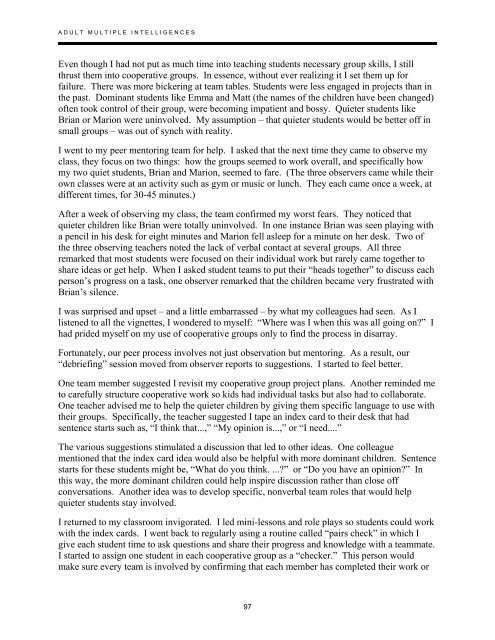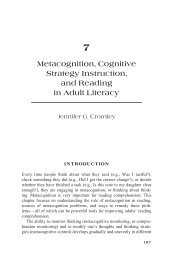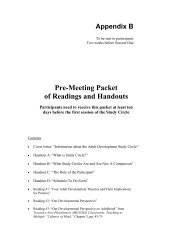Handouts and Articles on Classroom Observation, Peer Coaching ...
Handouts and Articles on Classroom Observation, Peer Coaching ...
Handouts and Articles on Classroom Observation, Peer Coaching ...
You also want an ePaper? Increase the reach of your titles
YUMPU automatically turns print PDFs into web optimized ePapers that Google loves.
A D U L T M U L T I P L E I N T E L L I G E N C E SEven though I had not put as much time into teaching students necessary group skills, I stillthrust them into cooperative groups. In essence, without ever realizing it I set them up forfailure. There was more bickering at team tables. Students were less engaged in projects than inthe past. Dominant students like Emma <str<strong>on</strong>g>and</str<strong>on</strong>g> Matt (the names of the children have been changed)often took c<strong>on</strong>trol of their group, were becoming impatient <str<strong>on</strong>g>and</str<strong>on</strong>g> bossy. Quieter students likeBrian or Mari<strong>on</strong> were uninvolved. My assumpti<strong>on</strong> – that quieter students would be better off insmall groups – was out of synch with reality.I went to my peer mentoring team for help. I asked that the next time they came to observe myclass, they focus <strong>on</strong> two things: how the groups seemed to work overall, <str<strong>on</strong>g>and</str<strong>on</strong>g> specifically howmy two quiet students, Brian <str<strong>on</strong>g>and</str<strong>on</strong>g> Mari<strong>on</strong>, seemed to fare. (The three observers came while theirown classes were at an activity such as gym or music or lunch. They each came <strong>on</strong>ce a week, atdifferent times, for 30-45 minutes.)After a week of observing my class, the team c<strong>on</strong>firmed my worst fears. They noticed thatquieter children like Brian were totally uninvolved. In <strong>on</strong>e instance Brian was seen playing witha pencil in his desk for eight minutes <str<strong>on</strong>g>and</str<strong>on</strong>g> Mari<strong>on</strong> fell asleep for a minute <strong>on</strong> her desk. Two ofthe three observing teachers noted the lack of verbal c<strong>on</strong>tact at several groups. All threeremarked that most students were focused <strong>on</strong> their individual work but rarely came together toshare ideas or get help. When I asked student teams to put their “heads together” to discuss eachpers<strong>on</strong>’s progress <strong>on</strong> a task, <strong>on</strong>e observer remarked that the children became very frustrated withBrian’s silence.I was surprised <str<strong>on</strong>g>and</str<strong>on</strong>g> upset – <str<strong>on</strong>g>and</str<strong>on</strong>g> a little embarrassed – by what my colleagues had seen. As Ilistened to all the vignettes, I w<strong>on</strong>dered to myself: “Where was I when this was all going <strong>on</strong>?” Ihad prided myself <strong>on</strong> my use of cooperative groups <strong>on</strong>ly to find the process in disarray.Fortunately, our peer process involves not just observati<strong>on</strong> but mentoring. As a result, our“debriefing” sessi<strong>on</strong> moved from observer reports to suggesti<strong>on</strong>s. I started to feel better.One team member suggested I revisit my cooperative group project plans. Another reminded meto carefully structure cooperative work so kids had individual tasks but also had to collaborate.One teacher advised me to help the quieter children by giving them specific language to use withtheir groups. Specifically, the teacher suggested I tape an index card to their desk that hadsentence starts such as, “I think that...,” “My opini<strong>on</strong> is...,” or “I need....”The various suggesti<strong>on</strong>s stimulated a discussi<strong>on</strong> that led to other ideas. One colleaguementi<strong>on</strong>ed that the index card idea would also be helpful with more dominant children. Sentencestarts for these students might be, “What do you think. ...?” or “Do you have an opini<strong>on</strong>?” Inthis way, the more dominant children could help inspire discussi<strong>on</strong> rather than close offc<strong>on</strong>versati<strong>on</strong>s. Another idea was to develop specific, n<strong>on</strong>verbal team roles that would helpquieter students stay involved.I returned to my classroom invigorated. I led mini-less<strong>on</strong>s <str<strong>on</strong>g>and</str<strong>on</strong>g> role plays so students could workwith the index cards. I went back to regularly using a routine called “pairs check” in which Igive each student time to ask questi<strong>on</strong>s <str<strong>on</strong>g>and</str<strong>on</strong>g> share their progress <str<strong>on</strong>g>and</str<strong>on</strong>g> knowledge with a teammate.I started to assign <strong>on</strong>e student in each cooperative group as a “checker.” This pers<strong>on</strong> wouldmake sure every team is involved by c<strong>on</strong>firming that each member has completed their work or97





